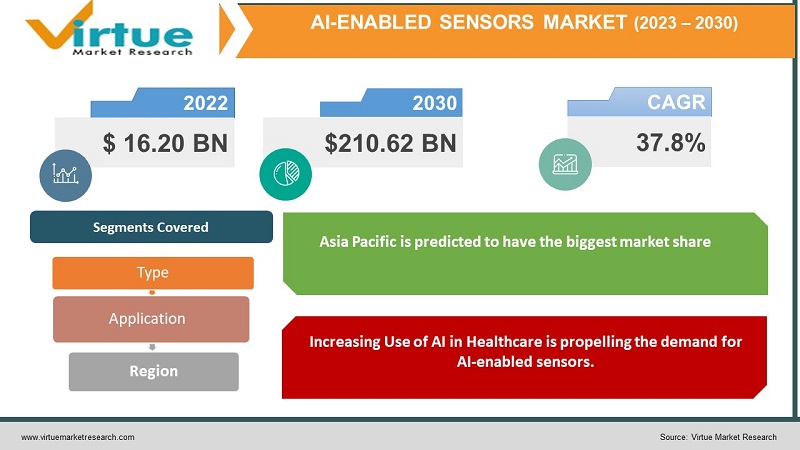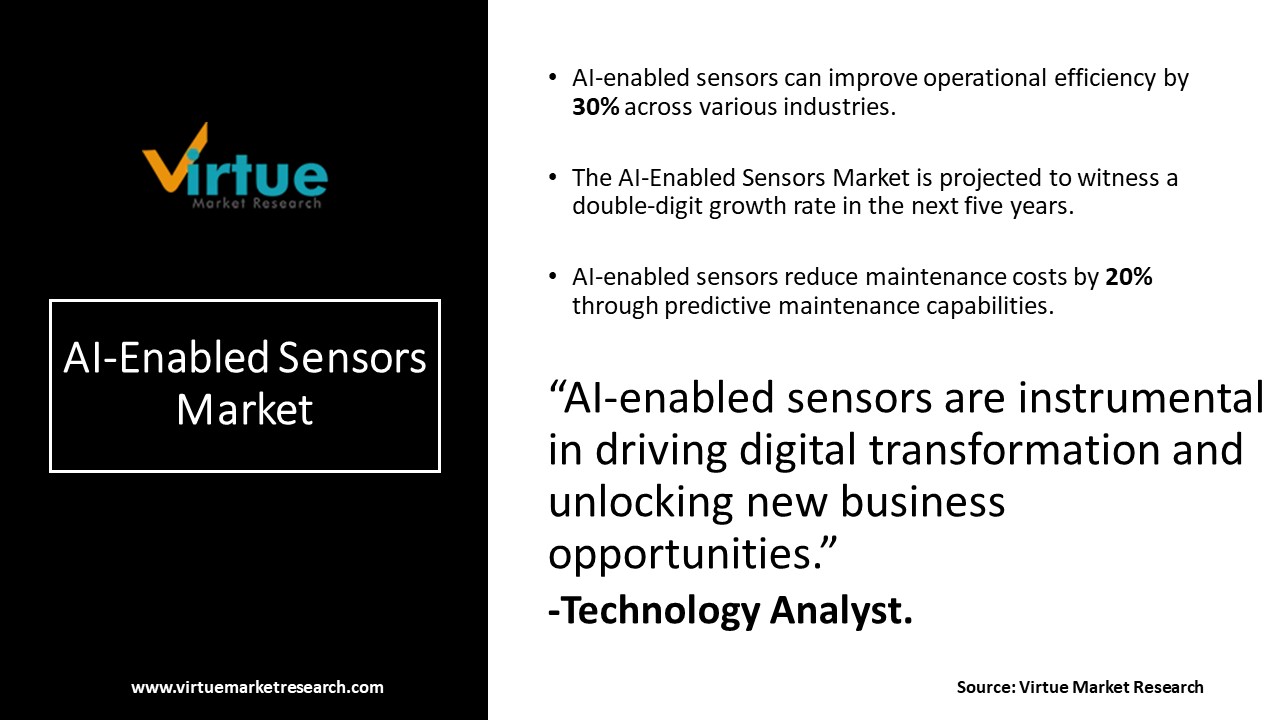Global AI-Enabled Sensors Market Size (2023 – 2030)
The Global AI Enabled Sensors Market was esteemed at USD 16.20 Billion in 2022 and is projected to be USD 210.62 Billion by 2030, growing at a fast CAGR of 37.8% during the forecast period 2023-2030.

Manufacturers of AI-capable sensors are referred to as the "AI-enabled sensors business." These gadgets gather data in real time, analyse it with cutting-edge algorithms and machine learning methods, and use the results of that analysis to produce justifiable inferences and predictions. Due to the growing demand for smart products and the Internet of Things, the market for AI-enabled sensors is anticipated to grow rapidly in the coming years (IoT). The consumer products, manufacturing, automotive, aerospace, and healthcare sectors all use sensors that are AI-powered.
AI-enabled sensors can be used in a variety of industries, including consumer products, healthcare, automotive, aerospace, and industrial, to make informed decisions and anticipate outcomes based on real-time data. The market for AI-enabled sensors is anticipated to propel quickly over the next few years as demand for smart products and the Internet of Things increases. These sensors will provide vital data regarding user health and well-being in addition to allowing predictive maintenance, quality control, and process optimization across a variety of uses.
Global AI-Enabled Sensors Market Drivers:
Growing Demand for IoT Devices and Smart Devices is fuelling the market growth.
The growing demand for IoT and smart products is one of the key reasons driving the market for AI-enabled sensors. The popularity of connected devices, smart homes, and smart cities is driving an enormous demand for sensors that can collect and analyse data in real time. Intelligent sensors with AI powers have been developed as a result, and they can analyse data and base decisions and predictions on it. Home automation is a major field in which AI-enabled sensors are used. A few examples of smart home appliances that increasingly include AI-enabled sensors that can detect environmental changes and adjust settings properly include thermostats, lighting controls, and security systems. A smart thermostat, for instance, might use an AI-enabled sensor to identify people in a space and then change the temperature following their preferences. The car sector is another field where AI-enabled sensors are in use. Radar, LIDAR, and cameras are just a few of the sensors used by connected and autonomous automobiles to gather information about their environments. These statistics are analysed by AI algorithms, which then determine how the vehicle should react.
Increasing Use of AI in Healthcare is propelling the demand for AI-enabled sensors.
The growing application of AI in healthcare is a significant market driver for AI-enabled sensors. Medical imaging, drug discovery, and patient tracking are just a few of the healthcare applications that make use of AI-enabled sensors. These sensors’ real-time data collection and analysis capabilities help healthcare workers make better decisions about patient care. A major use for AI-enabled sensors is patient tracking. Two examples of wearable technology that increasingly include sensors that can collect data on a user's heart rate, level of exercise, and sleeping patterns are smartwatches and fitness trackers. AI systems examine this data to extract details about a user's overall health and well-being.

Global AI-Enabled Sensors Market Challenges:
One of the greatest problems confronting the industry for AI-enabled sensors is the lack of standards and interoperability between various platforms and sensors. Sensors and platforms must be able to communicate and exchange data with one another without any problems as the number of IoT and connected devices increases. The inability of various hardware and software platforms to communicate with one another, however, can cause compatibility problems and delays in the creation and rollout of new applications and services. Common standards and protocols must be created to solve this issue and guarantee that sensors with AI powers can cooperate successfully.
Global AI-Enabled Sensors Market Opportunities:
The growing application of sensors in industrial automation and robotics presents a major commercial opportunity for those with AI capabilities. Complex robotic systems that are capable of performing difficult tasks effectively can be built using sensors and AI algorithms working together. Numerous sectors, including manufacturing, healthcare, and agriculture, could be transformed by this. AI-enabled sensors can increase productivity, cut expenses, and open up new revenue opportunities for businesses, making this a lucrative market for sensor makers and developers.
COVID-19 Impact on Global AI-Enabled Sensors Market:
The global market for AI-enabled sensors has been impacted by the COVID-19 pandemic in both good and negative ways. On the downside, the pandemic has slowed down the production and delivery of sensors and other components by upsetting global supply networks. For some businesses, this has resulted in rising expenses and declining earnings. Positively, as businesses look for ways to automate and streamline their operations, the pandemic has sped up the uptake of digital technologies, including IoT devices and connected sensors. As a result, businesses in the market for AI-enabled sensors now have more opportunities, especially in the fields of remote monitoring, smart homes, and healthcare.
Global AI-Enabled Sensors Market Recent Developments:
-
In September 2020, Panasonic (Japan) first introduced AI-enabled freezers in India. They have features like intelligent door sensors, intelligent light sensors, intelligent temperature sensors, AG clean technology, and jumbo storage. The intelligent light sensor can analyse both indoor and outdoor temperatures to change the compressor speed, in opposition to the Econavi sensor, which analyses door usage patterns. Greater convenience and energy economy are features of Panasonic's new refrigerators for consumers.
-
In November 2020, Bosch Sensortec introduced a self-learning AI sensor designed for activity tracking. Its system-in-package is 3.6 X 4.1 mm, and includes a 32-bit customizable programmable controller, a 6-axis IMU, and a wide variety of software functionalities. The unique hardware-software co-design allows the sensor to execute different firmware functions depending on user context.
AI ENABLED SENSORS MARKET REPORT COVERAGE:
|
REPORT METRIC |
DETAILS |
|
Market Size Available |
2022 - 2030 |
|
Base Year |
2022 |
|
Forecast Period |
2023 - 2030 |
|
CAGR |
37.8% |
|
Segments Covered |
By Type, Application and Region |
|
Various Analyses Covered |
Global, Regional & Country Level Analysis, Segment-Level Analysis, DROC, PESTLE Analysis, Porter’s Five Forces Analysis, Competitive Landscape, Analyst Overview on Investment Opportunities |
|
Regional Scope |
North America, Europe, APAC, Latin America, Middle East & Africa |
|
Key Companies Profiled |
Infineon Technologies, Panasonic, Bosch Sensortec, Siemens, Sony, STMicroelectronics Qualcomm Technologies |
Global AI-Enabled Sensors Market Segmentation:
Global AI Enabled Sensors Market Segmentation: By Type
-
Pressure Sensors
-
Position Sensors
-
Temperature Sensors
-
Others
Pressure sensors, position sensors, temperature sensors, and other sensor types are available on the worldwide market for AI-enabled sensors. Temperature sensors are anticipated to have the largest market share of these products due to their wide range of uses in sectors like healthcare, automotive, and aircraft. Another reason boosting demand for temperature sensors is the growing acceptance of smart cities and homes. Because of their growing use in industrial automation and robotics, pressure sensors are likely to see substantial growth. The market for position sensors is anticipated to expand rapidly as demand for autonomous vehicles and drones rises. The other section includes sensors used in environmental monitoring and air quality control, such as humidity and gas sensors, which are also in high demand. The market for AI-enabled sensors is anticipated to expand significantly over the next few years as connected sensors and IoT devices become more widely used across a range of sectors.
Global AI Enabled Sensors Market Segmentation: By Application
-
Cognitive Science
-
Robotics
-
Natural Interface
Cognitive science, robotics, and natural interface are additional application segments for the worldwide market for AI-enabled sensors. Robotics is anticipated to have the largest market share among these categories due to the arising use of automation and robotics across a range of sectors, including manufacturing, healthcare, and logistics. The growing use of AI algorithms and sensors in neuroscience research and brain-machine interfaces is anticipated to propel the growth of the cognitive science market at a significant rate. Applications like voice recognition, gesture control, and facial recognition are included in the natural interface segment and are in high demand due to their use in consumer devices, automobiles, and healthcare. Demand for IoT gadgets and linked sensors is likely to rise significantly over the next few years in several sectors, including robotics, cognitive science, and natural interface. The market for AI-enabled devices will be driven by this.
Global AI Enabled Sensors Market Segmentation: By Region
-
North America
-
Europe
-
Asia Pacific
-
Middle East
-
Latin America
The worldwide AI-enabled sensors market can also be segmented by region into North America, Europe, Asia Pacific, the Middle East, and Latin America. Asia Pacific is predicted to have the biggest market share among these areas thanks to the growing use of IoT devices and connected sensors across a range of sectors, including manufacturing, automotive, and healthcare sectors. The demand for AI-enabled sensors is being driven by significant investments being made in machine learning and AI technologies in the area. Due to the presence of top sensor manufacturers and AI technology firms in the region, North America is also anticipated to expand at a significant rate. Due to the growing use of automation and robotics across a variety of sectors, Europe is also anticipated to experience significant growth. Overall, the demand for connected devices and IoT applications is likely to fuel substantial growth in the market for AI-enabled sensors across all regions.
Global AI Enabled Sensors Market Key Players:
-
Infineon Technologies
-
Panasonic
-
Bosch Sensortec
-
Siemens
-
Sony
-
STMicroelectronics
-
Qualcomm Technologies
Chapter 1. AI-ENABLED SENSOR MARKET– Scope & Methodology
1.1. Market Segmentation
1.2. Assumptions
1.3. Research Methodology
1.4. Primary Sources
1.5. Secondary Sources
Chapter 2. AI-ENABLED SENSOR MARKET – Executive Summary
2.1. Market Size & Forecast – (2023 – 2030) ($M/$Bn)
2.2. Key Trends & Insights
2.3. COVID-19 Impact Analysis
2.3.1. Impact during 2023 - 2030
2.3.2. Impact on Supply – Demand
Chapter 3. AI-ENABLED SENSOR MARKET – Competition Scenario
3.1. Market Share Analysis
3.2. Product Benchmarking
3.3. Competitive Strategy & Development Scenario
3.4. Competitive Pricing Analysis
3.5. Supplier - Distributor Analysis
Chapter 4. AI-ENABLED SENSOR MARKET - Entry Scenario
4.1. Case Studies – Start-up/Thriving Companies
4.2. Regulatory Scenario - By Region
4.3 Customer Analysis
4.4. Porter's Five Force Model
4.4.1. Bargaining Power of Suppliers
4.4.2. Bargaining Powers of Customers
4.4.3. Threat of New Entrants
4.4.4. Rivalry among Existing Players
4.4.5. Threat of Substitutes
Chapter 5. AI-ENABLED SENSOR MARKET - Landscape
5.1. Value Chain Analysis – Key Stakeholders Impact Analysis
5.2. Market Drivers
5.3. Market Restraints/Challenges
5.4. Market Opportunities
Chapter 6. AI-ENABLED SENSOR MARKET – By Type
6.1. Pressure Sensors
6.2. Position Sensors
6.3. Temperature Sensors
6.4. Others
Chapter 7. AI-ENABLED SENSOR MARKET – By Application
7.1. Cognitive Science
7.2. Robotics
7.3. Natural Interface
Chapter 8. AI-ENABLED SENSOR MARKET – By Region
8.1. North America
8.2. Europe
8.3. Asia - Pacific
8.4. Middle East
8.5. Latin America
Chapter 9. AI-ENABLED SENSOR MARKET – By Companies
9.1. Infineon Technologies
9.2.Panasonic
9.3. Bosch Sensortec
9.4.Siemens
9.5.Sony
9.6. STMicroelectronics
9.7. Qualcomm Technologies
Download Sample
Choose License Type
2500
4250
5250
6900
Frequently Asked Questions
The Global AI Enabled Sensors Market was esteemed at USD 16.20 Billion in 2022 and is projected to be USD 210.62 Billion by 2030, growing at a fast CAGR of 37.8% during the forecast period 2023-2030.
The Global AI Enabled Sensors Market drives the growing Demand for IoT Devices and Smart Devices.
The Segments under the Global AI Enabled Sensors Market by the application are Cognitive Science, Robotics, and Natural Interface.
China, Japan, South Korea, Singapore, and India are the most dominating countries in the Asia Pacific region for the Global AI Enabled Sensors Market.
Qualcomm, Infineon Technologies, and Panasonic are the three major leading players in the Global AI Enabled Sensors Market.



